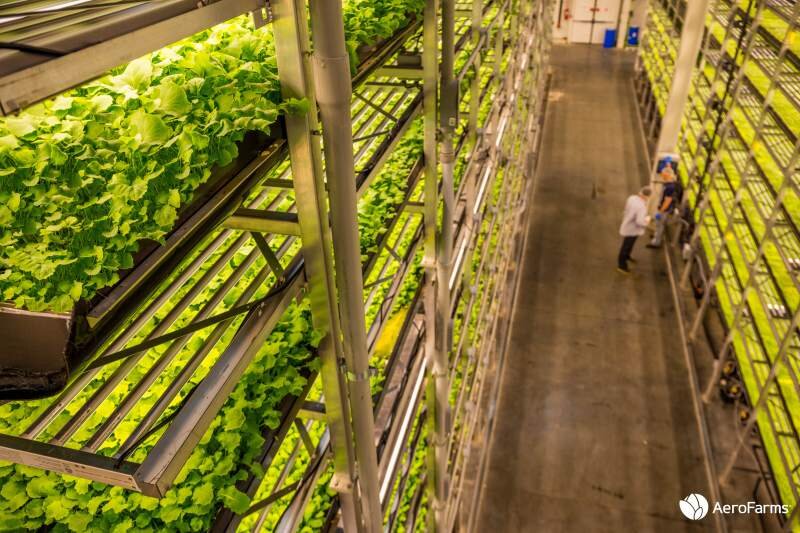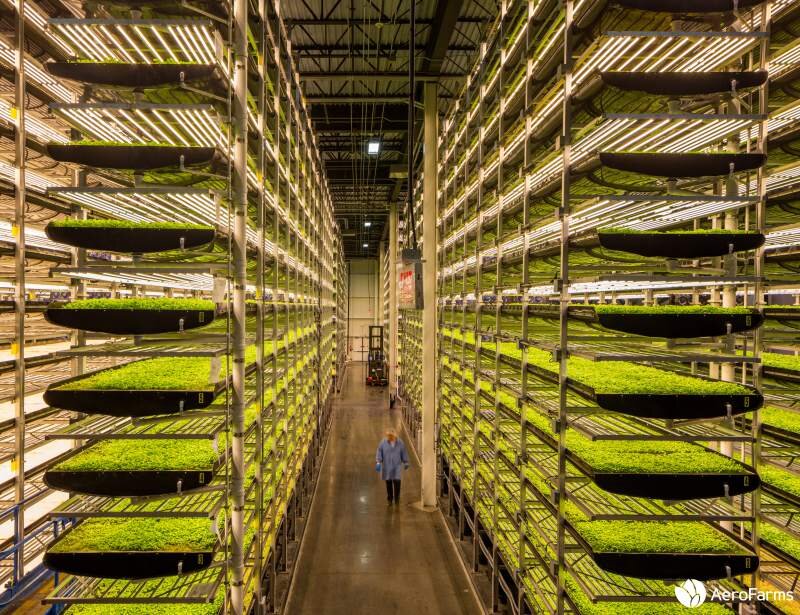AeroFarms Reveals To California North Coast Food Producers Its High-Tech Controlled Environment Agriculture
NORTH BAY BUSINESS JOURNAL March 2, 2020
CHERYL SARFATY
Imagine a farming method so efficient that you could grow a variety of leafy greens in half the time it traditionally takes — without any pesticides, herbicides or fungicides — and where the sun has no role.
It’s all done indoors, and it’s a growing trend known as controlled environment agriculture (CEA). The biggest player in the space is AeroFarms, a Newark, New Jersey-based operation that was among the businesses that participated at the Feb. 25 North Coast Specialty Food & Beverage Conference.
“We track everything that happens to the plants, from its genetics all the way to harvest. And by measuring along the way, we can use that data to learn more about what makes plants grow,” said AeroFarms Chief Financial Officer Guy Blanchard. “The ability to do this is transformative, it’s brand new if you think of the difference with field farming, where you can’t control the temperature and you can’t control the weather. You’re really reacting and trying to respond to the things that Mother Nature is throwing at you.”
In addition to AeroFarms, which is privately held, there are a variety of CEA players in the marketplace, including Bright Farms, Little Leaf Farms, Bowery Farms, Revol Greens and Plenty, which is based in South San Francisco. The majority of these businesses are headquartered in the Midwest and further east, where bad weather makes it impossible to grow the greens outdoors.
There are a variety of growing methods within the CEA category, the two most common being hydroponics and aeroponics. With hydroponics, plants are grown with mineral nutrients in a water base rather than in soil. Aeroponics, which is AeroFarms’ method, also uses no soil, instead of planting seeds in fabric and misting them with mineral nutrients.
AeroFarms grows 800 varieties of edible greens, such as lettuce, arugula, and spinach. The plants require 95% less water than on farms and are completely grown in 12 to 14 days, rather than 30 to 45 days in the field. The company’s retail brand, Dream Greens, is sold in grocery stores in New Jersey and New York.
Blanchard declined to disclose the company’s financial metrics. According to ROI-NJ, a New Jersey business publication, AeroFarms raised $40 million in 2017.
The vertical farming market size was valued at $2.23 billion in 2018 and projected to hit $12.77 billion by 2026, according to Allied Marketing Research.
There’s going to be change, but I don’t want to lose our small farmers.
Pegi Ball, Santa Rosa Original Certified Farmers Market
Pegi Ball and Janet Ciel, who each run farmers markets in the North Bay, said at the conference they wonder how the CEA industry might someday impact the region’s farmers“.
There’s going to be change, but I don’t want to lose our small farmers,” said Ball, who manages the Santa Rosa Original Certified Farmers Market at the Luther Burbank Center for the Arts. “It’s more than just lettuce and that sort of thing. It’s the culture, it’s the tradition, it’s our community, so that’s what concerns me.”Ciel, who manages the Healdsburg Certified Farmers Market and also works with the Agricultural Institute of Marin’s Stonestown Farmers Market in San Francisco, came away impressed by Blanchard’s presentation, but also curious about how traditional farming and controlled environment agriculture could potentially coexist.
“I think the technology is brilliant,” Ciel said.
“I just think the small farmer is … dealing with the weather and pests and (various other factors), and they don’t have the funding or the education to pull something like this off. Is there something there that is for them?”
Blanchard views the growing CEA industry to be more comparable to — and therefore more competitive with — commercial food-processing operations than traditional farming because of the costs involved, from investing in capital equipment to staffing, of which AeroFarms employs about 160 people.
“If you’re going to have a farm manager, a safety manager, a shipping manager and a maintenance manager (among the staff), you may be up to like $600,000 a year in wages and benefits before you’ve even gotten to anything really related to the farm,” Blanchard said. “In many ways, even though the processes are different, this isn’t different than some other food-processing (businesses) necessarily, and you’ve got to manage it.”
I’m certain we’ll continue to see new and different commodities take advantage of innovative growing techniques of a controlled environment.
Mary Coppola, United Fresh Produce Association
Another reason CEA poses little to no threat to farmers, at least at this point in time, is because food grown in this vertical indoor environment is limited primarily to leafy greens. Greenhouses have more latitude.
“There are a number of companies who are growing greenhouse strawberries, peppers, cucumbers and tomatoes with much success,” said Mary Coppola, vice president for marketing and communications at United Fresh Produce Association. The Washington, D.C.-based organization was founded in 1904 and advocates for companies in the fresh produce supply chain. “I’m certain we’ll continue to see new and different commodities take advantage of innovative growing techniques of a controlled environment.”
And where agriculture industry experts laud controlled environment agriculture for its renewable and sustainable efforts, such as conserving land and water, there are other cost concerns.“
They rely a lot on artificial lighting, so obviously energy consumption is an issue,” said Humberto Izquierdo, agricultural commissioner, and sealer of weights and measures for Napa County. “I think the economics have to be there.”
Guy Blanchard, chief financial officer of AeroFarms, explains how the New Jersey-based startup gets dozens of turns of fresh produce annually through its vertical indoor farm, speaking at North Bay Business Journal’s North Coast Specialty Food and Beverage Industry Conference on Tuesday, Feb. 25, 2020, at Doubletree Hotel by Hilton Sonoma Wine Country in Rohnert Park. (Jeff Quackenbush / North Bay Business Journal)
Blanchard said he doesn’t view energy consumption as a challenge for AeroFarms.“I think when people think about energy or environmental footprint, it’s tough to see how much is really embedded in traditional agriculture when you have all the energy going to root watering, soil and soil degradation, and the energy that goes into fertilizers and harvesting a field,” Blanchard said, as well as transporting, cooling and washing.
Marc Oshima, AeroFarms co-founder, and chief marketing officer said the company and its competitors are focused on strengthening the overall agriculture industry, such as sharing their expertise about how to grow greens safely to avoid contamination. They also formed their own group, called the Controlled Environment Agriculture Food Safety Coalition.
“(It) was a critical step to establishing best practices and educating the FDA and customers on why indoor farming has so many more safeguards versus traditional field farming, and less exposure that often occurs with co-mingling at the major leafy greens processors, who are sourcing from multiple growing regions both domestically and internationally,” he said.
The coalition also has partnered with Foundation for Food and Agriculture Research on a $2 million, three-year program to identify stressors of leafy greens in order to optimize taste and nutrition, he said.
Staff Writer Cheryl Sarfaty covers tourism, hospitality, health care, and education. Reach her at cheryl.sarfaty@busjrnl.com or 707-521-4259.





